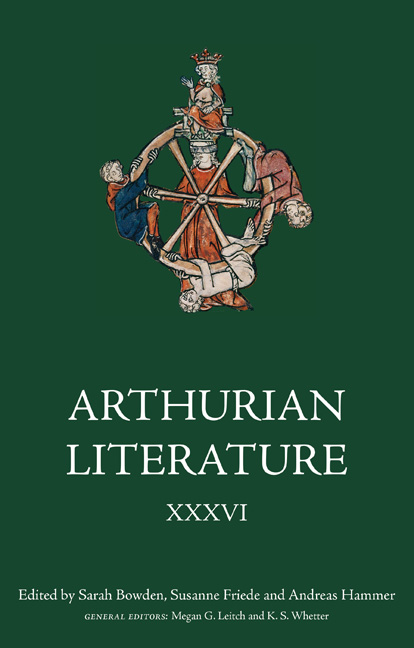Book contents
- Frontmatter
- Contents
- General Editors’ Preface
- List of Contributors
- Introduction: Sacred Space and Place in Arthurian Romance
- 1 The Church and the Otherworld: Sacred Spaces in the Matière de Bretagne and Medieval Ireland
- 2 Sacred Spaces: the Syntagmatic and Paradigmatic Construction of Narrated Space in Chrétien’s Conte du Graal
- 3 Perceiving the Way: Sacred Spaces and Imaginary Pilgrimage in the Vulgate Cycle Queste del Saint Graal and Thomas Malory’s ‘Tale of the Sankgreal’
- 4 Affirming Absence and Embracing Nothing: on the Paradoxical Place of Heterosexual Sex in Medieval French Verse Romance
- 5 Spaces of Remorse: Penitential Allusions in Iwein
- 6 The Spatial Narratives of Salvation and Damnation in Wigalois and the Prose Lancelot
- 7 ‘Fantoum and Fayryȝe’: Visions of the End of Arthurian Britain
- 8 The Tomb of the Kings: Imperial Space in Arthur’s Camelot
- Contents of Previous Volumes: Details of Earlier Titles are Available from the Publishers
1 - The Church and the Otherworld: Sacred Spaces in the Matière de Bretagne and Medieval Ireland
Published online by Cambridge University Press: 17 April 2021
- Frontmatter
- Contents
- General Editors’ Preface
- List of Contributors
- Introduction: Sacred Space and Place in Arthurian Romance
- 1 The Church and the Otherworld: Sacred Spaces in the Matière de Bretagne and Medieval Ireland
- 2 Sacred Spaces: the Syntagmatic and Paradigmatic Construction of Narrated Space in Chrétien’s Conte du Graal
- 3 Perceiving the Way: Sacred Spaces and Imaginary Pilgrimage in the Vulgate Cycle Queste del Saint Graal and Thomas Malory’s ‘Tale of the Sankgreal’
- 4 Affirming Absence and Embracing Nothing: on the Paradoxical Place of Heterosexual Sex in Medieval French Verse Romance
- 5 Spaces of Remorse: Penitential Allusions in Iwein
- 6 The Spatial Narratives of Salvation and Damnation in Wigalois and the Prose Lancelot
- 7 ‘Fantoum and Fayryȝe’: Visions of the End of Arthurian Britain
- 8 The Tomb of the Kings: Imperial Space in Arthur’s Camelot
- Contents of Previous Volumes: Details of Earlier Titles are Available from the Publishers
Summary
There were various kinds of sacred space in the medieval world, as there still are: the consecrated spaces of churches and burial grounds but also the ‘Holy Places’ of pilgrimage. To these may be added locations pertaining to another version of the supernatural: the hills and lakes and wild places associated with the fairies, and Otherworlds outside the framework of mortal space. In the matière de Bretagne, and in the medieval Celtic literatures, these different kinds of sacred space are repeatedly juxtaposed, or even identified with one another.
In this contribution, I note those instances of such juxtaposition of which I am aware in Arthurian literature and in the Breton lais, together with a range of comparanda from medieval Ireland. Although I have a strong interest in Arthurian matters, I am by training a Celticist and not an Arthurian scholar per se: I offer the Irish specimens as parallels to a phenomenon that can be observed in the ‘matter of Britain’, in the hope that the resemblances may be of interest to specialists in the field. I do not, however, undertake to interrogate the evidence in terms of current Arthurian criticism, something for which others are better qualified.
Avalon and Glastonbury
Where is Avalon? The name first appears, so far as I am aware, in Geoffrey of Monmouth's Historia regum Britanniae (c. 1136): here we are told that this is the island where Arthur's sword Caliburnus was forged and to which the king was taken ‘for the healing of [his] wounds’, after having been ‘mortally’ struck in his last battle. This Avalon is evidently identical with the ‘Island of Apples’ (Insula Pomorum) included in a catalogue of islands in Geoffrey's Vita Merlini (c. 1150): the latter is described as a paradise of fertility and long life, ruled over by nine sisters who are skilled in healing and able to assume the forms of birds. ‘Morgen’ was the chief of these, and it was to her care that the wounded Arthur was entrusted. Thereafter, Avalon appears repeatedly in medieval literature as an elusive Otherworld, a place of delights and the home of beautiful fairy women.
- Type
- Chapter
- Information
- Arthurian Literature XXXVISacred Space and Place in Arthurian Romance, pp. 13 - 30Publisher: Boydell & BrewerPrint publication year: 2021



